Indulge in this juicy, garlic rosemary buttered steak, and serve it with my FAVORITE peri peri cream sauce and herby scalloped potatoes for the ultimate weekend meal! I'm also including what cut of beef is best, how big it should be and generally how to cook steaks because we don't want those chewy shoe soles at our dinner table!
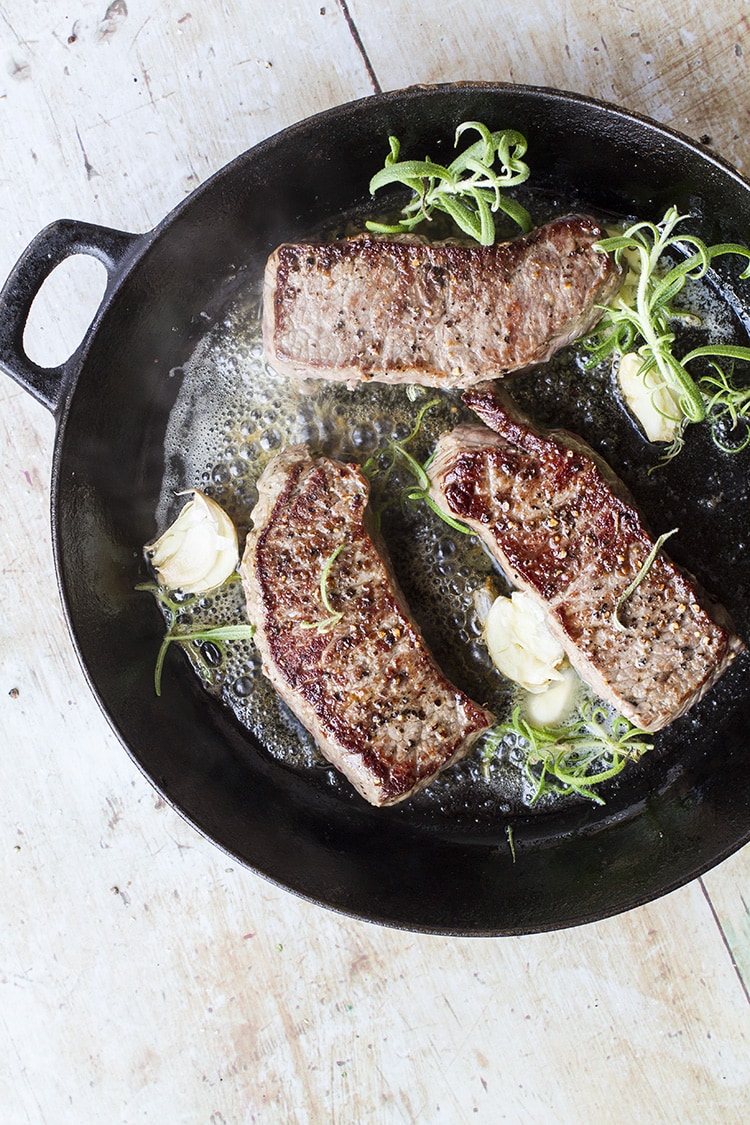
Comparing a tough, chewy steak with shoe soles may just be a Norwegian saying, but it explains exactly what we want to avoid. We want a big, juicy steak basted in butter, flavored with garlic and rosemary. It is also quick and easy to make, and it's so hard to go wrong with rosemary and garlic.
What cut of beef is best?
Generally, I only switch between these three cuts of meat:
- Filet mignon (tenderloin filet or tenderloin steak, indrefilet): an expensive cut perfect for special occasions. Its melt-in-your-mouth texture is exceptional, and is especially delicious with bacon wrapped around it.
- Striploin (New York strip steak, strip steak, ytrefilet) is usually the cut of beef I go for. It is cheaper than a filet mignon, it tastes beefier. It is not as melt-in-your-mouth, but usually always tender and delicious. Find one with great marbling and it will be even more flavorful.
- The rib eye (entrecôte in Norwegian and French): this cut is extremely flavorful due to the fat, also known as marbling, but not as tender as a filet mignon. Entrecôte is traditionally from the rib area (hence the rib eye in English), but my Googling skills led me to the 'fact' that you can make entreôte from the sirloin too, if it's cut properly.
That doesn't mean you can't cook great steaks with other cuts of beef, but these are generally always a good bet. Other parts that are popular are the top sirloin, T-bone, porterhouse and hanger steak. Either way, you should always look for great marbling!
Check this steak guide for a visual on the cuts of meats. If any Norwegian would need some help translating, you can use this Norwegian-English translation of cuts of meat.
Cuts of beef you should avoid
Cuts of beef you should avoid are parts of the animal that has a lot of muscles that are constantly in use. The muscle fibers are so tough and needs to be cooked for a long time to get tender. Examples of these are the chuck and brisket. These would be much more perfect in a slow cooker dish.
In summary, go for a filet mignon for special occasions, but depending on the terminology you use, either of these are also delicious: top sirloin, striploin, New York strip, the rib eye and entrecôte.
How big should a steak be?
According to Chicago Steak Company an 1 inch (2.5cm) steak is a good starting point, however the best steaks, especially when it comes to premium cuts like ribeyes are around 1.5 inches (4cm) in thickness.
I usually have a steak somewhere in-between these two. This garlic rosemary buttered steak is approximately 1 ¼ inch (3cm). With a thicker steak it is obviously easier to avoid overcooking. If it gets much thicker than this, you should consider just searing the steak and then finishing it off in the oven.
The best fat/oil to use when cooking steaks - smoke points
The one thing to remember when cooking steaks, is that you want to use high heat. And that is why you need to choose an oil that has a high smoke point, which means that the oil is burning and it can give a bitter taste or sometimes even harmful chemicals released.
Safe bets are canola oil, peanut oil, corn oil and vegetable oil. All of these have smoke points of more than 400F (200C), which is perfect for cooking steaks.
All that said, butter tastes amazing. Butter has a smoke point of 350F (175C) so it's generally not a good fat to cook with on high heat. There is a roundabout way of this though, and that is combining butter with a high smoke oil. You need to start off with the oil, and then add butter towards the end of the cook time.
Steak cooking times - how long to cook steaks
Steak cooking time will depend on the thickness of your meat, maybe even the cut of meat, your stove top, grill or anything, so it's not easy to know exactly when you should take it off the pan, but there are some general guidelines.
You can for example use the poke test to see how cooked it is. Pressing the fingers mentioned below together and then using your other index finger to press the fattiest part of your palm, right below your thumb, to check the consistency.
- Index finger + thumb: rare
- Middle finger + thumb: medium-rare
- Ring finger + thumb: medium-well
- Little finger + thumb: well done
Click this link to get a visual on how the poke-finger test works. The very best way to check if it is done, is by a meat thermometer, you can't be completely sure without it. If it isn't that important for you how cooked it is, you can also just use the ballpark minutes I mention below.
- Rare: 120-130°F (49-54°C) - 4-6 minutes
- Medium-rare: 130-135°F (54-57°C) - 6-8 minutes
- Medium: 140-145°F (60-63°C) - 8-10 minutes
- Medium-well: 150-155°F (66-68°C) - 10-12 minutes
- Well: 160-165°F (71-74°C) - 12+ minutes
Related: How to cook a rack of lamb
Again, this will also depend on the thickness of your steak. In my recipe I use a 1 ¼ inch steak (either rib-eye or striploin) and cooked it to medium rare for about 6-7 minutes total.
General tips for how to cook steaks
Here I'll include some of the tips that are not already mentioned elsewhere in this post. I know there are a lot of contradictory opinions regarding some of these, but I've mostly used Gordon Ramsay as my source.
- Cut the steaks against the grain to get a tender cut. It's however not always easy to see!
- Let the steak come to room temperature for around 20 minutes to avoid overcooking the outside.
- Dry the steak with a paper towel to get the perfect crust (known as the Maillard reaction). Do not rinse it in water as you spread bacteria around your kitchen.
- Be seriously heavy on the seasoning and rub it in. It is better to over-season than under.
- Do not use a non-stick pan - choose the cast iron skillet or the grill. We need high heat to get that beautiful crust! The Maillard reaction happens at around 300F (175C).
- Flip every minute to get an even cook. And always on high heat. (If you want a well-done steak you should cook it for 2-4 minutes on each side on high heat, before turning the heat down to cook another 4-6 minutes.)
- When adding butter, garlic and herbs, do it towards the end of the cook time (or halfway through). Baste the beef with the butter-oil and rub the top of the steaks with the garlic and herbs for more flavor. Pro-tip: use some delicious compound butters for a nice twist.
- Let it rest for 10 minutes to relax the fibers in the meat, the meat will also lock in the juice making it juicier. This is the perfect time to make the peri peri sauce!
What to serve with garlic rosemary buttered steak
Honestly, I'm not one of those that can grill a steak and call it a day. I love the sides! Sides can make the dish a completely different one each time, even though the garlic rosemary buttered steak is the same.
Combination #1:
As I have mentioned a few times already, the ultimate way to serve this is with a creamy peri peri sauce and herby scalloped potatoes. You would also need something fresh so I'm pan-frying halved tomatoes and sometimes serve it with boiled broccoli or asparagus.
Combination #2:
Another combination I LOVE is a baked potato with spiced compound butter and a side salad. I haven't yet shared my recipes for baked potato, but I love this strawberry salad as the fresh element.
Other side dishes that are amazing to steaks
- Garlic Parmesan Green Beans or Lemon Roasted Asparagus
- Savory Sweet Potato Mash
- Rosemary Fries with Garlic Cream Cheese Dip
- Patatas Bravas with Spicy Tomato Aïoli
- literally any kind of potato dish like turmeric potatoes or hasselback potatoes
- pan fried mushrooms and onions or these garlic mushrooms
- steamed/boiled vegetables like asparagus, broccoli and carrots
- fresh salads
- sauces like béarnaise sauce, pepper sauce and red wine sauces (try this red wine sauce from my lamb chops recipe!).
Scroll down to find a printable recipe card of the garlic rosemary buttered steak. Enjoy!
Did you like this garlic rosemary buttered steak recipe? Here's some more side dishes I think you would love:
- Garlic Butter Wilted Kale
- Herby Scalloped Potatoes
- Savory Sweet Potato Mash
- Garlic Parmesan Green Beans
- Peri Peri Cream Sauce (The BEST steak sauce!)
- Chanterelle Cream Sauce
I’d love to hear your thoughts. Comment below or tag me @thegingerwithspice on Instagram. And don’t forget to Pin it for later! To make sure you’re never missing another recipe, please feel free to subscribe to my newsletter. As a thanks you will receive a free e-cookbook Travels Through the Seasons, with many delicious recipes from around the world that suit different seasons of the year.
In order to keep the blog up and running this post may contain affiliate links, it will be at no extra cost to you, please read the disclosure for more information.
Download your FREE copy of Travels Through the Seasons Cookbook here!
📖 Recipe
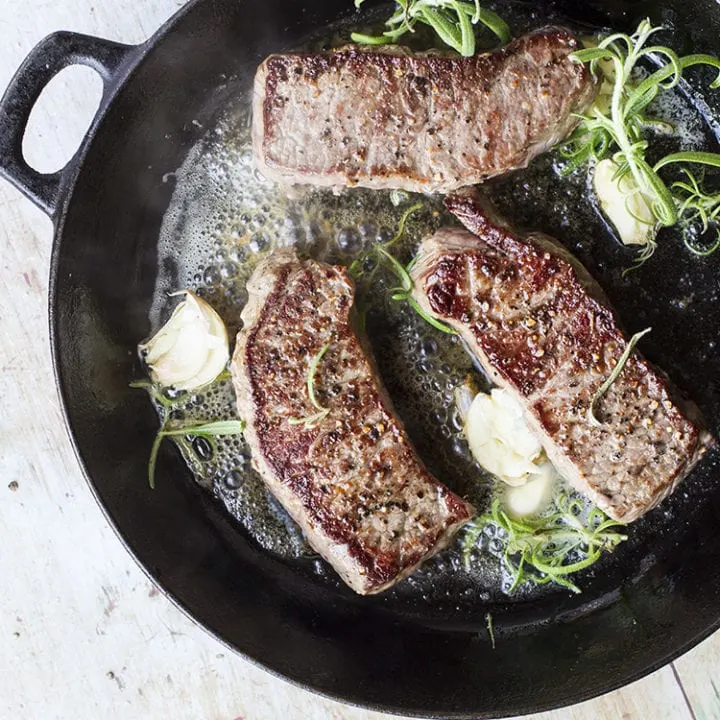
Garlic Rosemary Buttered Steak (How to Cook Steaks)
Nothing beats a juicy garlic rosemary buttered steak for a weekend treat! Easy with very little hands-on time.
Ingredients
- 3 sirloin or rib-eye steaks (about 1 ¼ inch thick)
- Salt and pepper (generous amount)
- 2 tablespoon corn oil (or canola, peanut, vegetable)
- 1-2 tablespoon butter
- 2 cloves garlic (smashed)
- 2 sprigs fresh rosemary (or thyme)
Instructions
- Prepare the beef: Dry the steaks with a paper towel and let them sit in room temperature for 20 minutes before crackling a generous amount of both salt and pepper on all sides. Rub the seasonings into the meat.
- Add corn oil or other high temperature oil to a cast iron skillet on high heat. Let this be really hot before the next step.
- Cook the steaks for about 6-8 minutes for medium-rare. Flip them every minute to get an even cook. The last 3 minutes, add in the butter, garlic and rosemary. If really thick steaks, you should also flip to the sides.
- Usin a spoon, baste (pour the butter over) the beef with the butter oil and rub the garlic on top of the steaks. Let them rest for 10 minutes before serving.
- Best served with peri peri cream sauce and scalloped potatoes and some fresh or pan fried halved tomatoes.
Notes
See blog post for different cook times if you want it something else than medium-rare. I've also included several side dishes and other useful information.
Nutrition Information:
Yield: 3 Serving Size: 4.5 oz (130g) steaksAmount Per Serving: Calories: 360Total Fat: 21.1gSaturated Fat: 6.7gCholesterol: 126mgSodium: 113mgCarbohydrates: 0.9gFiber: 0.2gSugar: 0gProtein: 39.7g
Nutrition information isn't always accurate, estimate for informational purposes only.

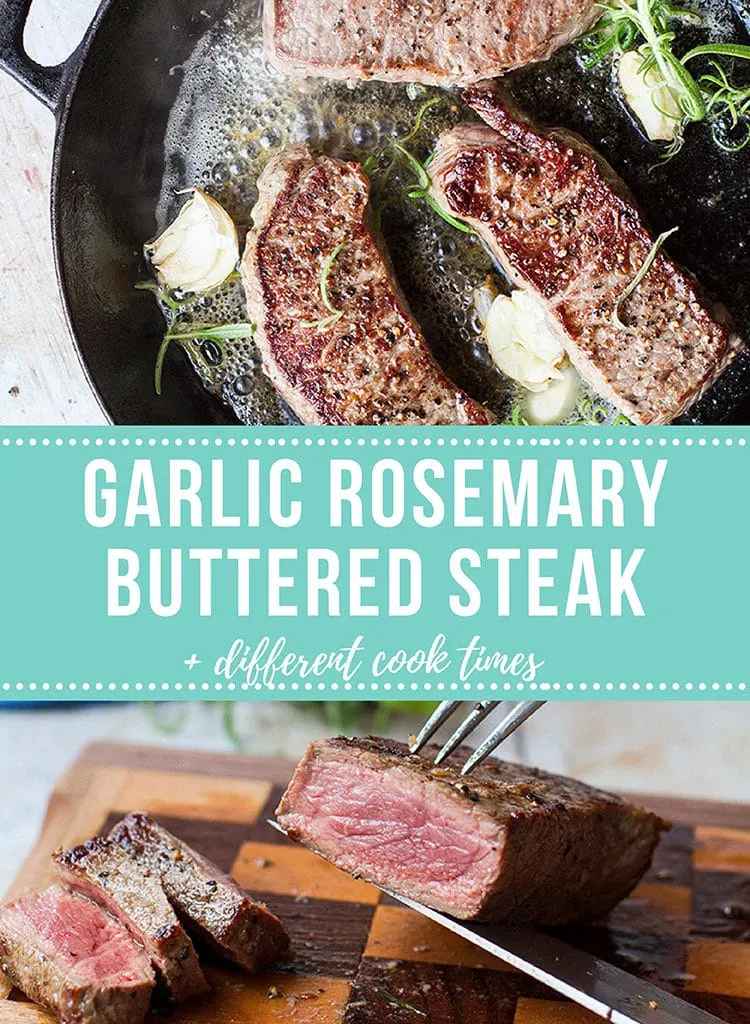
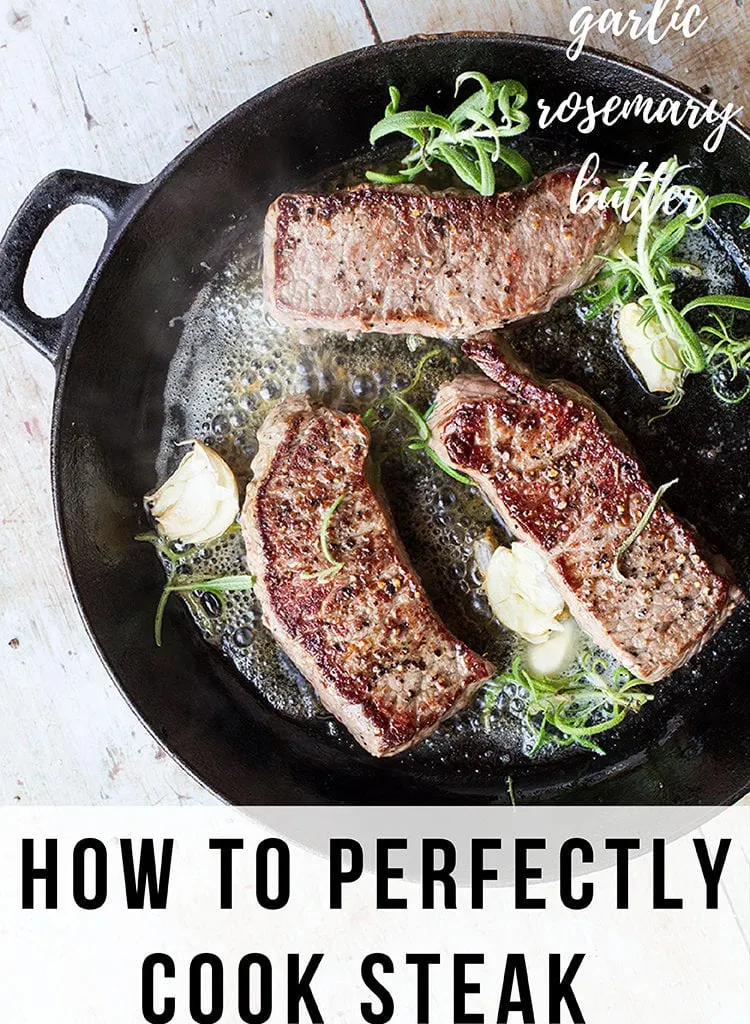
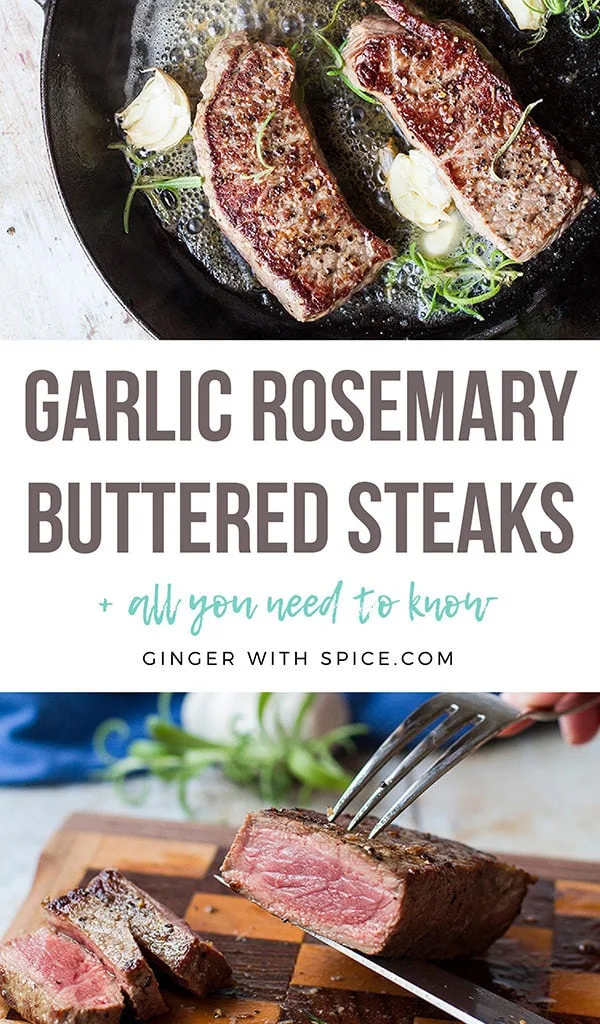
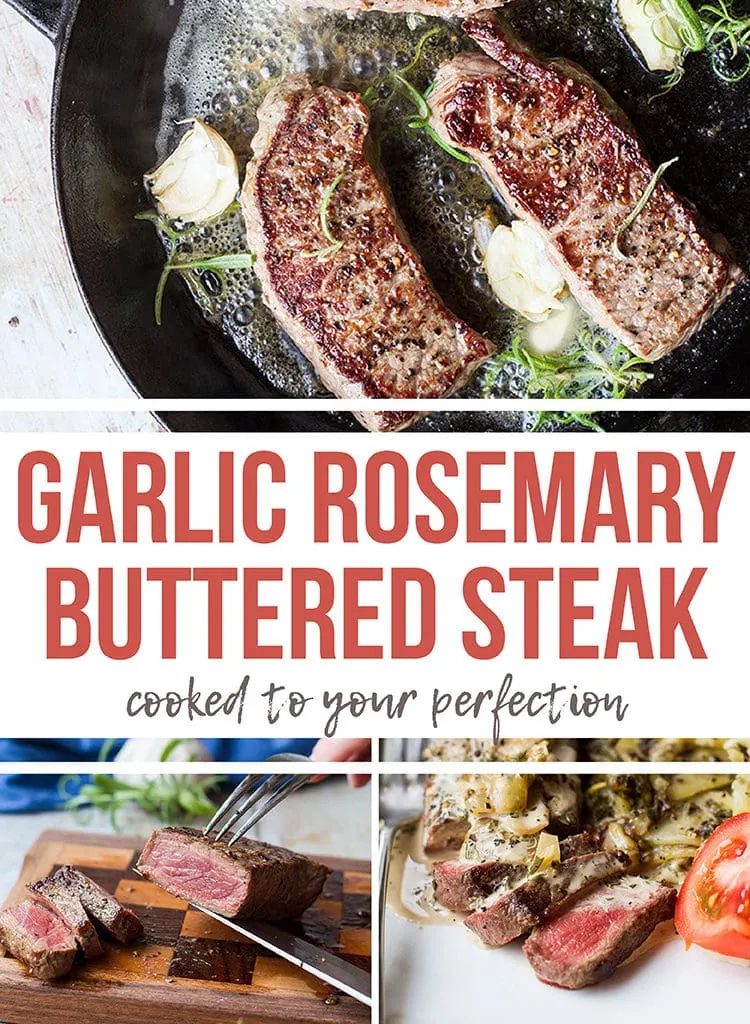
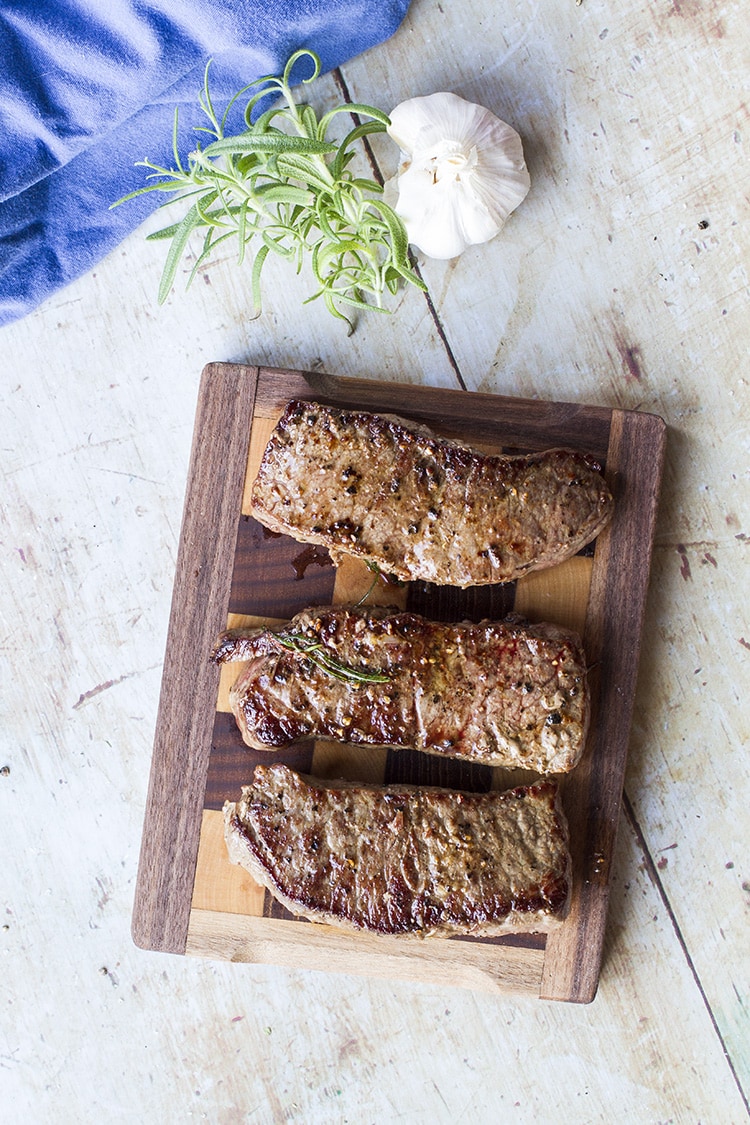
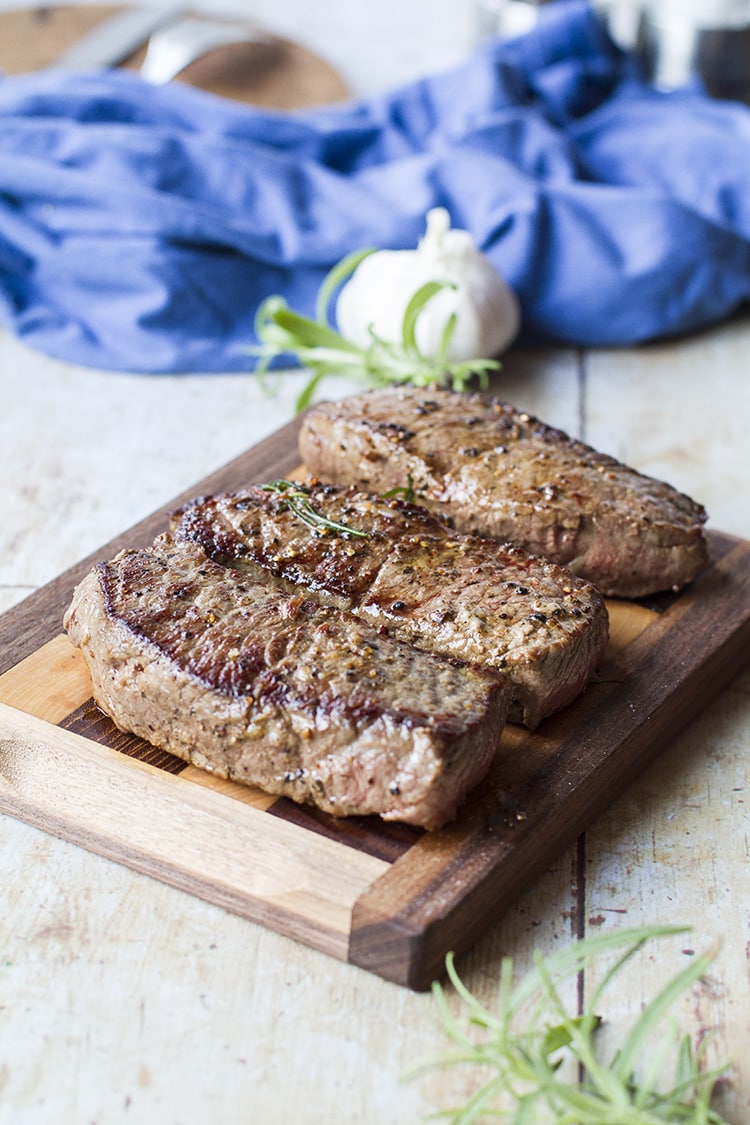
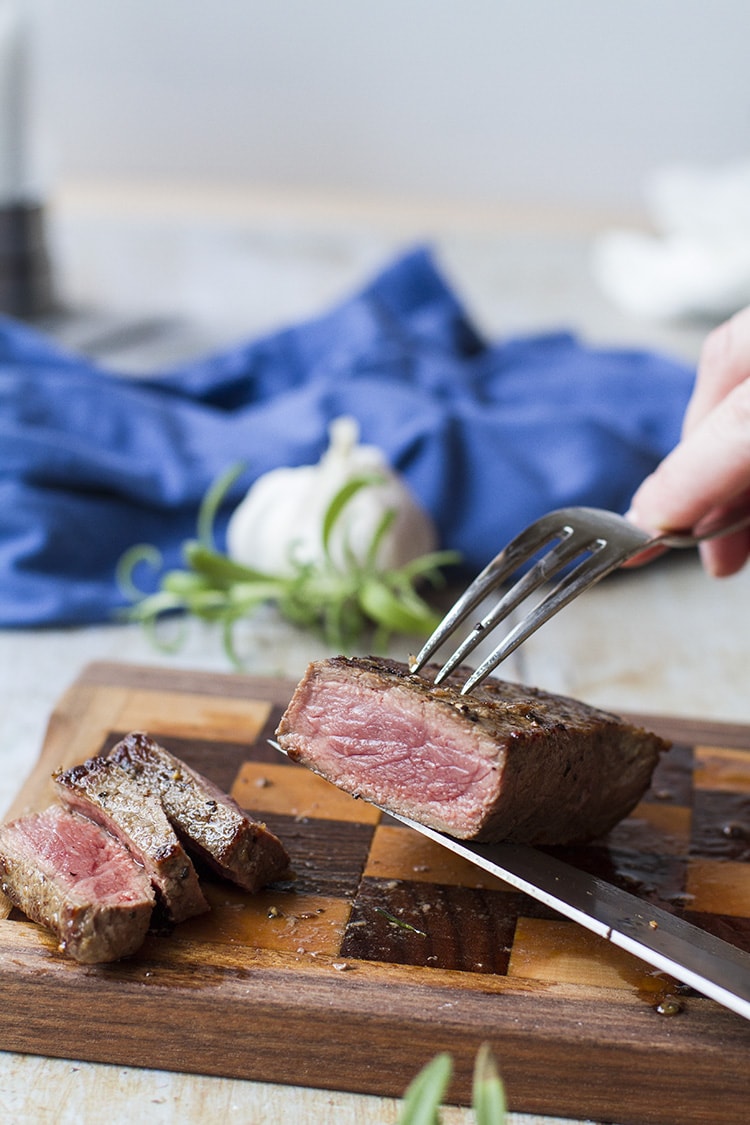
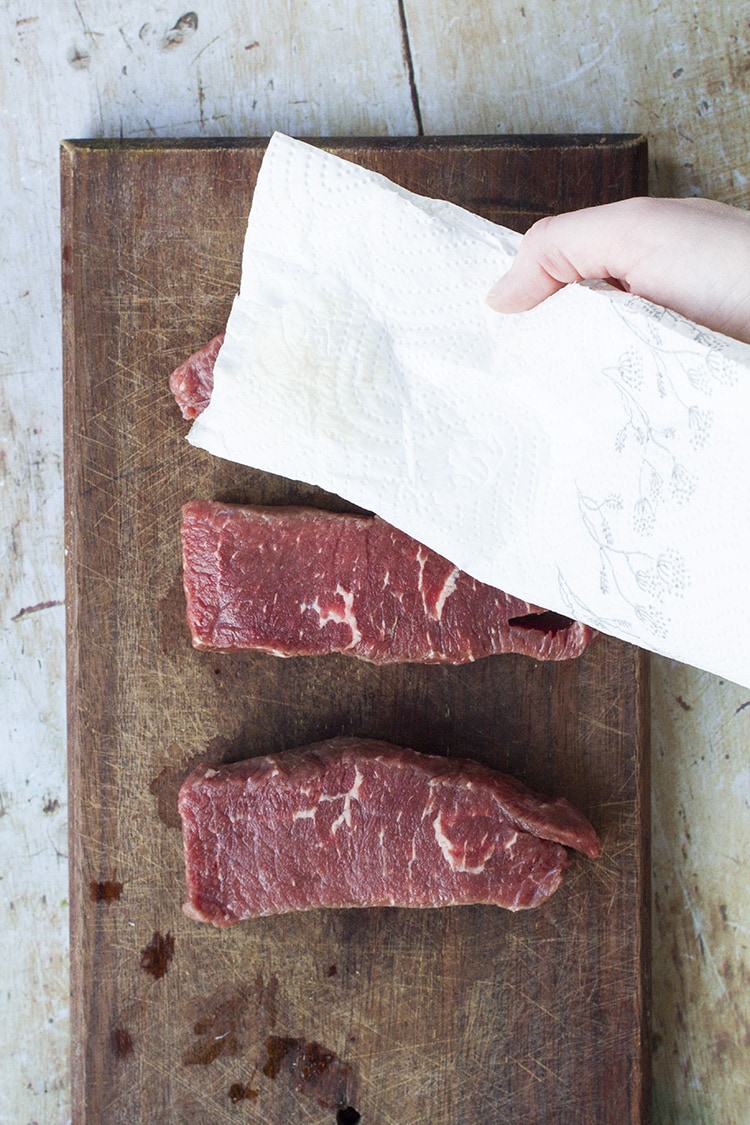
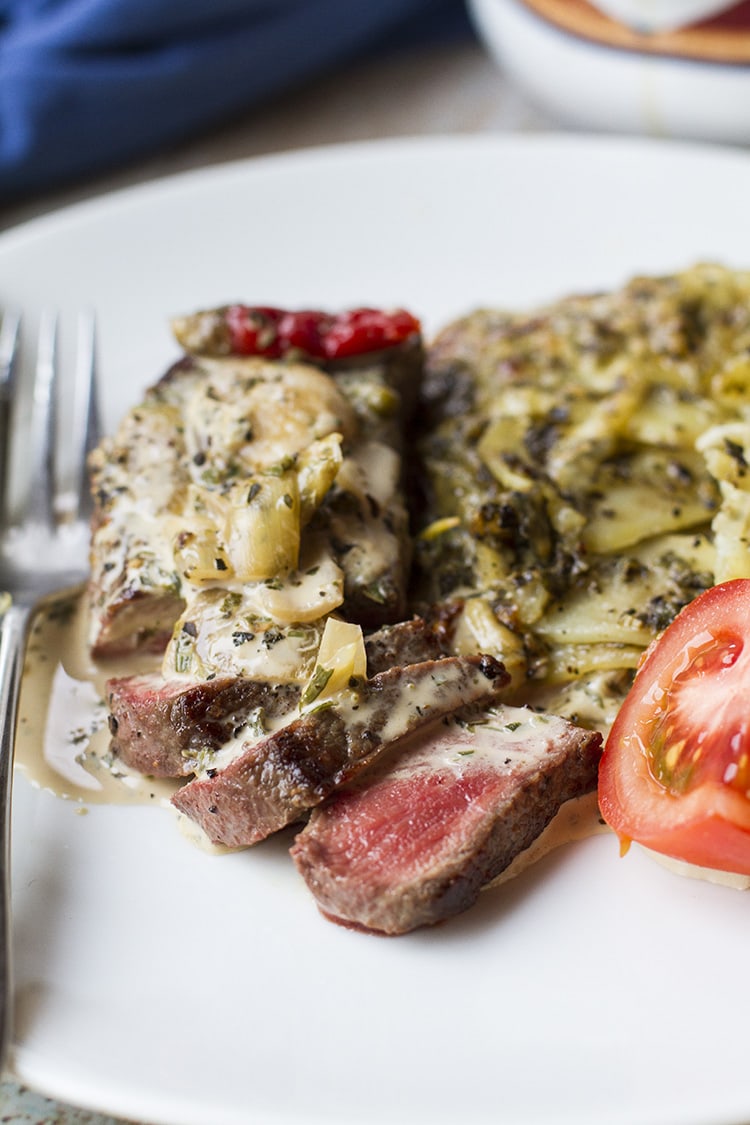
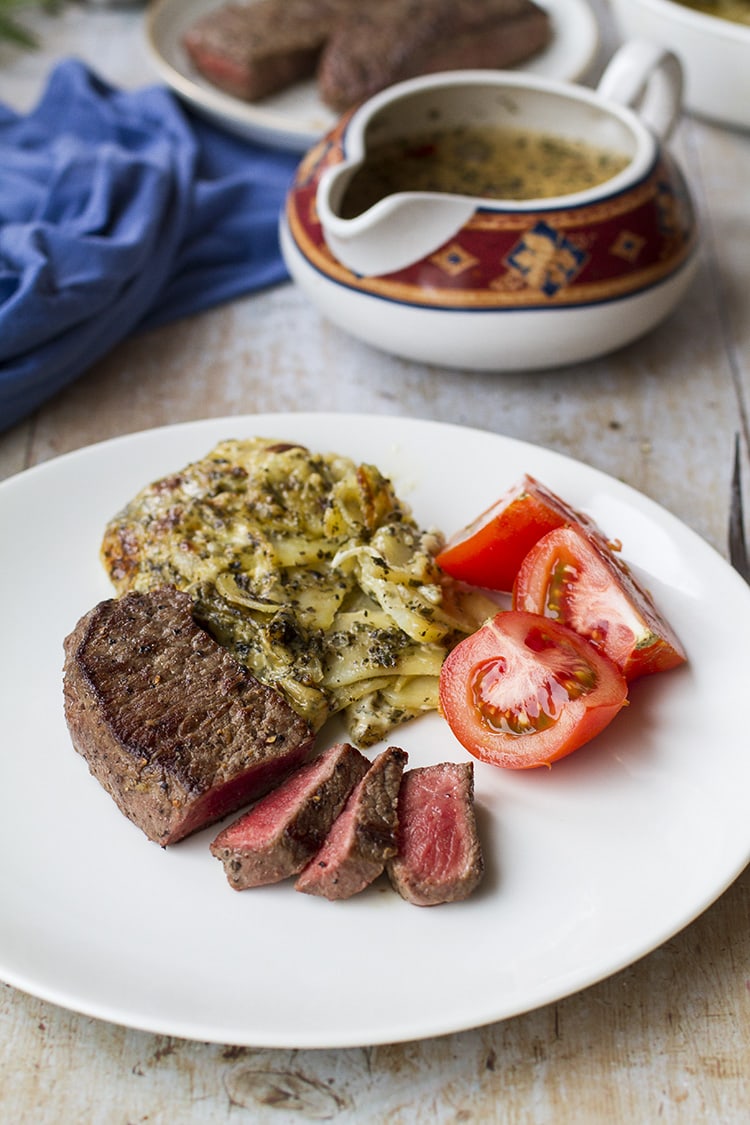
Chef Dennis
Wednesday 18th of November 2020
I love a good pan seared steak! And thanks for all the helpful cooking tips.
Stine Mari | Ginger with Spice
Wednesday 18th of November 2020
Thank you!
Genevieve | Fitty Foodlicious
Tuesday 17th of November 2020
This recipe looks amazing and look at those gorgeous steaks! The perfect dinner indeed!
Stine Mari | Ginger with Spice
Wednesday 18th of November 2020
Thank you so much, Genevieve!
Kushigalu
Tuesday 17th of November 2020
What a great meal idea. Love the flavor combination in this steak. Pinned bed to try this soon.
Stine Mari | Ginger with Spice
Tuesday 17th of November 2020
Thank you so much, I hope you will like it!
Gail Montero
Monday 16th of November 2020
These steaks look perfectly cooked and right up my alley. Pinned this for future reference as I certainly need help in cooking steak perfectly!
Jacqueline Debono
Monday 16th of November 2020
I really love a good steak for dinner. Yours looks cooked to perfection. I also checked out your recipe for pero peri cream sauce. I think I'm definitely going to be serving my steak with that!
Stine Mari | Ginger with Spice
Tuesday 17th of November 2020
Thank you so much, I truly hope you try that peri peri cream sauce as well - divine!